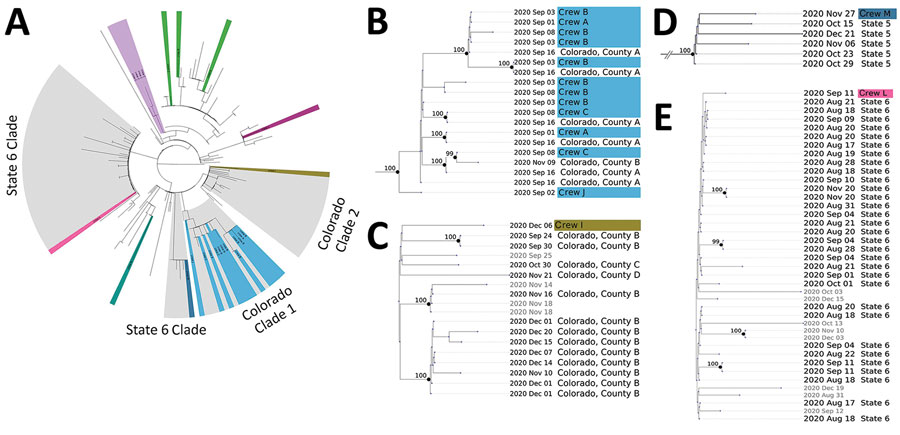Volume 28, Number 8—August 2022
Synopsis
Investigation of COVID-19 Outbreak among Wildland Firefighters during Wildfire Response, Colorado, USA, 2020
Figure 2

Figure 2. Contextual phylogenetic tree and enlarged clades showing genetic relatedness of the Cameron Peak firefighter sequences to sequences of SARS-CoV-2 collected within the United States during September–December 2020. A) Full contextual tree constructed using 754 contextual sequences subsampled from GISAID (https://www.gisaid.org) plus 24 Cameron Peak firefighter consensus sequences. The phylogeny has been pruned to display 164 contextual sequences and Cameron Peak firefighter sequences. Cameron Peak sequences are highlighted in color according to their lineage assignment. Clades highlighted in gray represent potential community and interstate transmission events. Cameron Peak sequences assigned to lineage B.1.2 (green) do not cluster together on the contextual phylogeny to form a monophyletic group, suggesting that they are genetically divergent from one another and likely do not represent a single transmission event, despite belonging to the same lineage. Mutation differences among these sequences are shown in detail in Figure 1. B) Colorado clade 1. Twelve Cameron Peak firefighters formed a monophyletic group with sequences from 2 Colorado counties. C) Colorado clade 2. A single Cameron Peak firefighter sequence formed a clade with sequences collected from 3 Colorado counties and additional sequences collected from outside of Colorado (not labeled). Low support values for this clade may be expected because of low sequence diversity. D) State 5 clade. The Cameron Peak firefighter sequence formed a monophyletic clade with sequences collected from his or her state of deployment (State 5). E) State 6 clade. The Cameron Peak firefighter sequence formed a clade with sequences collected from his or her state of deployment (state 6) and additional sequences collected from outside of Colorado and not from his or her state of deployment (not labeled). Low support values for this clade may be caused by low sequence diversity. For panels B–E, all sequences within a clade are assigned the same lineage. Collection dates are labeled for all tips. Cameron Peak firefighter sequences are highlighted according to their lineage and labeled with crew. Nodes with at least 95% ultrafast bootstrap support values are labeled. Additional information is available in the Appendix.